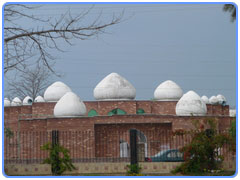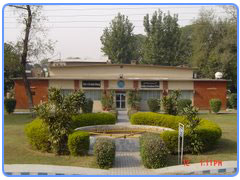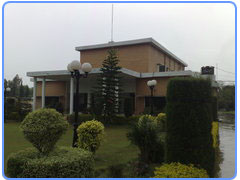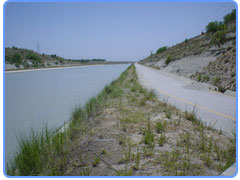|
|
Neighbours |
Name | Population |
Resources | History |
Main Tribes | Pashtun/Pathan|
Hindu- Population Before 1947 |
Notables of Attock District |
Creation
The district was created in April 1904 by the merger of Talagang Tehsil in
the Jhelum District with the Pindigheb, Fatehjang and Attock tehsils from
Rawalpindi District of the Punjab province of British India
Search
Attock On Satellite Map
Places of Interest
| Hotels |
Parks & Gardens |
Educational Institutes |
Hospitals |
Banks |
ATM |
CNG- Stations |
Police Stations |
Neighbours
Attock District is bordered by the Haripur and Swabi districts of North-West
Frontier Province to the north, the district of Rawalpindi to the east, the
district of Chakwal to the southeast, the district of Mianwali to the
southwest, and North-West Frontier Province districts of Kohat and Nowshera
to the west and northwest. The river Indus forms the western boundary of the
district.
Go To Top
Name
Attock District original name was Attock it changes Campbellpur after the
Briton Sir Campbell who founded the city of Campbellpore. The name of the
district was changed to Attock as of 1978 again. Attock city is the district
headquarters
Go To Top
Population
According to the 1998 census of Pakistan the district had a population of
1,274,935 of which 20.45% were urban, The estimated population in 2008 was
1.58 million.
The city also had a significant Muhajir population. In fact, Attock city was
dominated by the immigrants from India but gradually their population has
dwindled and now they are a minority - mostly living in old quarters of
Attock city
Go To Top
Resources
Dhullian is a village in Pindigheb Tehsil. This village has important
resources namely Oil and Gas. It has been providing oil since the 1930s.
There are all types of soil as mountains, plain areas fertile grounds and it
also has a river flowing through it. There is a famous Ghala Mandi located
in Dhullian Chowk. Here 90% of the total population area agricultural. This
historical village is located at the end of Attock District
Go To Top
History
According to the Imperial Gazetteer of India:
The history of the District is practically the same as that of Rawalpindi
district. Hassan Abdal, the chief relic of the Buddhist period, was one of
the towns subordinate to the capital of Taxila, and under the Gakhars,
Mughals, and Sikhs the District followed the fortunes of Rawalpindi. The
chief historical events recorded are the defeat of Anand Pal near Ohind by
Mahmud of Ghazni, the foundation of ATTOCK by Akbar, and its vicissitudes in
the Sikh Wars. The District was constituted in 1904,
the tahsils of Attock, Pindi Gheb, and Fatahjang being transferred from Rawalpindi District, and that of Talagang from Jhelum.
Ancient History
Pāṇini was an ancient Indian scholar who was born between the 7th and 4th
centuries BC in Shalatula, a town near to Attock on the Indus river in
present day Pakistan. He is regarded by scholars as one of the most
innovative people in the whole development of knowledge. He was a Sanskrit
grammarian who gave a comprehensive and scientific theory of phonetics,
phonology, and morphology.
The Astadhyayi (also known as Astaka) is Panini's major work.
“ In this work Panini distinguishes between the language of sacred texts and
the usual language of communication. Panini gives formal production rules
and definitions to describe Sanskrit grammar. Starting with about 1700 basic
elements like nouns, verbs, vowels, consonants he put them into classes. The
construction of sentences, compound nouns etc. is explained as ordered rules
operating on underlying structures in a manner similar to modern theory. In
many ways Panini's constructions are similar to the way that a mathematical
function is defined today ”
Citied from (J J O'Connor and E F Robertson, Panini Biography, 2000)
MacTutor History of Mathematics
-
Attock Fort
Attock fort was completed in 1583 under the supervision of Khawaja
Shamsuddin Khawafi, a minister of Emperor Akbar. The Mughal caravan sarai
outside the fort, which is almost on the Grand Trunk (GT) Road, was also
built during this period.
-
Gandhara
Gandhara (gəndä'rə) was an historic region of ancient India, (which
corresponds to areas of north west Pakistan including Attock). Situated
astride the middle Indus River, the region had Taxila and Peshawar as its
chief cities. It was originally a province of the Persian Empire and was
reached (327 B.C.) by Alexander the Great. The region passed to Chandragupta,
founder of the Maurya empire, in the late 4th cent. B.C., and under Asoka
was converted (mid-3d cent.) to Buddhism. It was part of Bactria from the
late 3d cent. to the 1st cent. B.C. Under the Kushan dynasty (1st cent.–3d
cent. A.D.), and especially under Kanishka, Gandhara developed a noted
school of sculpture, consisting mainly of images of Buddha and relief’s
representing scenes from Buddhist texts, but with marked Greco-Roman
elements of style. The art form flourished in Gandhara until the 5th
century, when the region was conquered by the Huns.
Find more about
History of Pakistan
Go To Top
Main Tribes
The Khattar, Syed,Paracha,Awans, Pathans, Bangashs, Gujjars, Rajput,Mughals
and Shaikhs are the main tribes of Attock District. The main Rajput tribes
are the Alpial, Jodhra, Janjua Chauhan and Bhatti. The Chauhan of Khaur, the
Alpial of Chakri and Jodhra of Kamlial are important families in the
district. The main Tribe of Royal Barlas Mughal's is Gheba.The Gheba Sardars
of kot Fateh khan,Dhurnal,Malal,Dhari-Rai-Ditta, Shah-rai-saidullah are
important families in the District.
Go To Top
Pashtun/Pathan
The Pashtun, or as they are referred to in the this region, as Pathans are
found principally in the Attock District and belongs to Qais Abdur Rashid
(father of all pashtuns). There are two Pathan settlements in that district,
one in the south-west of Pindigheb Tehsil at Makhad and in the Narrara hills
, the other in the Attock Tehsil, chiefly in the Chhachh illaqa. In
addition, there are also a few scattered villages, in Rawalpindi District
-
Sagri Khattak Pathans
The Pindigheb Pathans are practically all Sagri Pathans, a branch of the
Bulaki Khattaks. The Babar family of Bhangi Khel Khattaks is also
represented in the Narara hills. Another branch of the Khattaks, the Jamal
Khel also have a presence in settlements near the town of Makhad.
Accoding to their traditions, the khattaks came across the Indus river from
the neighbourhood of Kohat, and drove out the Awan, whom they found in
possession. The khattaks look up to the Khans of Makhad" Sher Ahmed Khattak",
as their headmen. They own seven villages, of which Makhad and Narara are
the largest. The village of Hadowali is their boundary to the east, where
the Awan are their neighbours. Throughout the tract they occupy, they have
completely dispossed all other tribes. Their speech is the soft or western
dialect of Pashto.
-
Chhachh Pathans
The Attock Pathans are found in two parts of the tehsil, those of Sarwala,
and those of Chhachh.The Chhachh Pathans have very little in common with the
Sagri khattaks, as they are separated by the Kala Chita mountains.The
chhachhies are also known as Chhachi (Pashtun). The Chhachh have Hindko and
pushto speaking community, and have much in common with the Pashtun tribes
settled in the neighbouring North West Frontier Province.Chhachh have
pukhtun culture and peoples are following Pashtunwali code of conduct
strictly like in NWFP.Mostly pathans in chhachh came with Ghaznavi from
Afghanistan.
The largest clan are the Alizai, who include the Tahirkheli, one of three
main septs of the Alizai. The Tahirkheli inhabit villages along the Haro
river. The other tribe along the Haro are the Sadozai, and both they and the
Alizai, are branches of the Durrani-tareens tribe. Together with the Manduri
and Barahzai, who are also found in numbers in the district, they are all
sections of the great Yousafzai tribe. By far the greater proportion of the
Attock Pathans are Yousafzai, allied to the Yousafzai of Swabi and Mardan
districts and other tribes are kakar,nasozai,barakzai,khattaks,lodhi,Bangash,
ismail khel,utmanzai,sadozai and many others
The Attock District Gazetteer gives the following description regarding
Pathan settlement in the district:
“The connection of Pathans with the tahsil is not very ancient. The
earliest comers may have been the Lodhis, who are a section of the Ghilzai
nation, and accompanied Mahmud Ghaznavi as mercenaries on his invasions of
India. Their numbers are inconsiderable. Next after a long interval came the
Dilazak who were gradually driven from the Safed Koh by the Yousafzai.About
the end of the 16th Century they crossed the river, and found the Chhachh,
then a swamp being slowly recovered from the Indus, in possession of the
Gujars. Apparently they never settled down and in consequence of the turmoil
caused by their constant attempt to recover Mardan illaqa of Peshawar from
the Yousafzais, were finally deported by Jahangir and scattered over the
India Peninsula. "A Gazetteer of Attock District 1929 Part A page 91 ”
“The great Pathan invasion of the Chhachh took place much latter. About the
end of the 17th Century the Khattaks, pushing up from Kohat at the
south,began to press on the flanks of the Yousafzai between Attock and
Peshawer of which they had been put in charge. At the same time too the
Gujars of Hazara has summoned the Yousafzais across the river to help
against the Tareen, a tribe of original Afghans of Jewish and Arab origin,
who had fallen on the Haripur plain. Later in the middle of the 18th Century
the Piro Khels who are Afridis and Pathans proper, came with Nadir Shah
perhaps from Persia, and remained behind when he returned.By the end of the
18th Century Dilazaks, Tareens, Yousafzais and Afridis had settled down in
the Tahsil, with the Yousafzai numerically immensely superior. Since then no
immigration has taken place. The chief accretion to Pathan strength has been
that of the Akhund Khel. Akhund is the title given to any chief of special
sanctity, and Akhundzada is the title of his descendants. Many Akhund Khel
are by origin Gujar and Awan. , perform no priestly functions, and live like
ordinary Pathans. The Tahirkheli Pathans who inhabit the north-east of the
Tahsil below the main wall of the Gandgarh Hills and along the line of the
Haro by tradition and sentiment have little to with Attock. They live or own
land in the Hazara District, and many are Jagirdars. ”
The Chhachh ilaqa is almost entirely held by the Pathans, as is the Nala
estates, along the Haro river valey. The Attock Pathans were the earliest
group of Pothoharis to start emigrating to Europe and North America.There
are now large communities of Chhachh Pathan settled in British cities, such
as Bradford and Manchester
Go To Top
Hindu Population Before 1947
Attock District had a heterogeneous mix of religious and ethnic populations
before 1947. The Gazetteer of the Attock District 1930 records
Hindus , who make up 8.5 %of the total population are by tribes and in
order of numerical importance , Khatris , Aroras , Brahmans and Mohyals
-
Khatris
“ Khatris , who number about 24000 make up the greater portion of the Hindu
population. ”
In Tallagang the Chhachi Sardars , whose ancestors held the tract under the
Sikhs are large Jagirdars but reside almost always in Gujranwala district ,
and have really little to do with Tallagang.
PP19 Attock-V Capt (r) Malik Aitabar Khan PML(Q) now joined PML(N)
-
Village of Thatta
Village of Thatta has been one of the most important villages of the
District. It is believed to have been founded by Sher Shah Suri, while some
believe that it was founded much earlier, in the time of Alexander's
invasion. The Khattar family of this village has played a very important
role in the progress of the country and the region.
Prominent Personalities of this Village Include
-
Sardar Lal Khan, known for his courage and bravery against the Bristish Raj
and Sikhs. He fought many wars against them and never accepted their
government. He was offered a lot of property, but declined; rather, he lost
a lot of his own property as a Freedom Fighter and political activist.
Although British colonial rulers did bring some other people against him
politically by rewarding them with big jageers, his influence never ended.
His sons, Sardar Zakri Khan and Sardar Ghulam Khan, also worked hard in the
political movement against British Raj
-
Major General Javed Afzal, Brig Afzal's Son, who served with the British
Army.
-
Brig. Afzal, political and social figure, Father of Javed Afzal.
Current Important Personalities Include
-
Sardar Saleem Khan, is a grandson of Sardar Lal Khan and son of Sardar
Ghulam Khan, a social worker, political activist, and founder of various
charity and philanthropic organizations, is currently Chairman of the Social
Development Organization, one of the largest NGOs in the District.
-
Sardar Abdul Rashid Khan, Advocate, elder brother of Sardar Saleem Khan,and
son of Sardar Ghulam Khan has played a very active role in the the
restoration of Judiciary.He is a distinguished lawyer of district. He is a
well respected and learned person, who commands respect in the whole region,
due to his humble and down to earth behaviour.
-
Cdr Abdul Qayyum Khan is also an important and widely respected personality.
He also belongs to Village of Thatta and grandson of Sardar Lal Khan. He has
been playing a very active social and political role since after his
retirement from Pakistan Navy on completion of his meritorious service.
-
Sardar Manzar Ameer is tehsil Nazim
Go To Top
Notables of Attock District
Sir Sikandar Hayat Khan, the politician and statesman of Undivided India and
Former Prime Minister of Undivided Punjab, of the important Khattar family.
Other
Notables Historically Include
-
Sardar Shaukat Hayat Khan,
-
Pir of Makhad, Uncle of Prime Minister Yousuf Raza Gillani.
-
Malik Allah Yar Khan
-
(late)Sardar Karam Khan (fateh jang)
-
Sardar Mumtaz Khan.
Current Notables Include
-
Sardar Tahir Sadiq Khan (District Nazim Attock)
-
Sh Aftab MNA
-
Sardar Salim Haider, Federal minister of State
-
Sher Afzal khan (president PPP)
-
Malik Hakmeen Khan
-
Sh Ahsan Hayat, advocate
-
CDR (R) Abdul Qayyum Khan, He belongs to Village of Thatta and famous
influential family. He has been playing a very active social and political
role since after his retirement from Pakistan
-
Navy on completion of his
meritorious service.
-
Sardar Abdul Rashid Khan, Advocate. A famous lawyer and social activist of
region.
-
Sardar Imtiaz Khan, Advocate, Preseident District Bar Association of Attock
In the educational sector, Attock has two universities. One is COMSATS and
the second is University of Education. There are several government and
private colleges; the Govt Postgraduate College is one of the oldest
institutions in the country with a degree college status dating from 1942.
PAF Shaheen College Kamra is also one of best institutions in the Region.
There is a famous Cadet College at Hassan Abdal.
Attock has produced lot of notables and hardworking individuals. Many people
from Attock are working in Middle Eastern countries, while others are
settled in United States of America, United Kingdom, European countries, and
Hong Kong
Go To Top |








